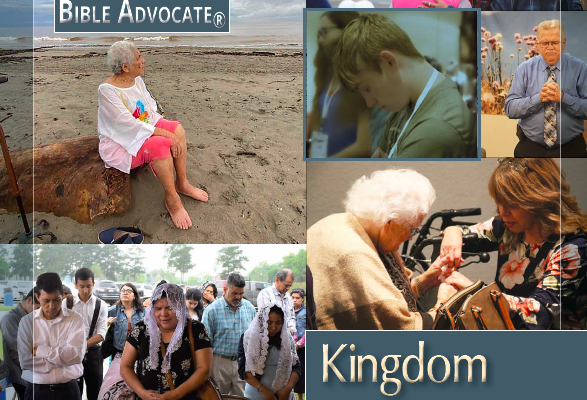In the last “Spotlight” we examined Revelation 21 and the new creation that began in Christ and the ministry of reconciliation. This time we focus on the new covenant. Just before Paul communicates that reconciliation is a God-given ministry and that we are ministers of God (2 Corinthians 5:18; 6:4), he writes that God has “also made us sufficient as ministers of the new covenant . . .” (3:6). These two ministries go hand in hand. In fact, they are one and the same.
Paul’s second epistle to the Corinthians has more to say about “the ministry” than all his other letters combined, and chapter 3 is his most concentrated expression on the subject. It’s also one of the most complex and profound statements the apostle (already well-known for deep and challenging teaching) ever wrote. With rich insight and imagery drawn from Scripture, Paul tells how we are both competent ministers of the new and readers of the old, by the Spirit.
Living letter
The chapter opens with Paul defending his ministry. Some are questioning it. Does he have the proper credentials? Where are his letters of recommendation (v. 1)? His response addresses this situation, but has far-reaching consequences for the nature of all Christian ministry: “Clearly you are an epistle of Christ, ministered by us, written not with ink but by the Spirit of the living God, not on tablets of stone but on tablets of flesh, that is, of the heart” (v. 3).
What better commendation could Paul offer than the community of faith in Corinth itself? They are a living letter, ministered by Paul. Paper and ink is little, compared to flesh and blood. Obviously, an incarnated message is far superior to an inscribed one. And here is a teachable moment that Paul takes advantage of to instruct on the ministry of the new covenant in which he and Corinth participate.
The careful reader will recognize the allusions to Scripture compressed in verse 3:
Exodus 31:18: And when He had made an end of speaking with him on Mount Sinai, He gave Moses two tablets of the Testimony, tablets of stone, written with the finger of God.
Jeremiah 31:33: “But this is the covenant that I will make with the house of Israel after those days, says the Lord: I will put My law in their minds, and write it on their hearts; and I will be their God, and they shall be My people.”
Ezekiel 36:26: “I will give you a new heart and put a new spirit within you; I will take the heart of stone out of your flesh and give you a heart of flesh.”
From the Law and the Prophets, Paul identifies and contrasts old and new covenants. The old communicated God’s message but failed because “the letter” is insufficient to conform hard hearts to His will. The new overcomes this. It makes us sufficient through the Spirit, transforming hearts (2 Corinthians 3:5). What was inscribed without could not bring obedience, but what is inscribed within will be embodied.
Letter vs. Spirit
From Exodus, Jeremiah, and Ezekiel, Paul can conclude “The letter kills, but the Spirit gives life” (v. 6). The contrast could not be sharper. The old is glorious; it is God’s revelation. But it was a ministry of condemnation and death because by it, sin was exposed — and the wages of sin is death. But how much more glorious is the new that is the ministry of the Spirit and righteousness unto eternal life (vv. 7-11)?
The condemnation and death of the old covenant is evident from the story itself. In only one verse we move from the extraordinary act of God writing the Ten Commandments on two tablets of stone with His own finger, to the erection of the golden calf (Exodus 31:18; 32:1). Three thousand died that day (a curious counterpoint to the three thousand saved when the Holy Spirit was poured out on the day of Pentecost) for Israel’s great sin, and the tablets with the covenant were broken (32:1-35).
This was just the first of many, many covenant-breaking moments. No wonder the prophets, situated in exile for Israel’s relentless rebellion, foresaw a new covenant, different from what had come before — a covenant ministry not just written down but written in, where stony tablets and hearts were exchanged for new hearts of Spirit enfleshed with God’s nature in Christ. The witness of the prophets is the experience of the church in Corinth. That’s Paul’s point. They have become the people of God by the ministry of the Spirit through Paul.
It is important to note that letter (gramma) doesn’t refer to Scripture (graphe), of which Paul speaks only positively as God’s authoritative revelation to the church (2 Timothy 3:16, 17). The content of the covenant is not in question; the law is written in both. It’s the covenant form that makes all the difference for covenant ministry: dead script or living Spirit? As an advocate of Scripture and writer of epistles, Paul is no enemy of words — God’s least of all. But only the Spirit can make letters live.
And Paul is just getting started.
Behind the veil
Paul continues reflecting on the events at Sinai. His imagination is captured by the story of Moses and the veil that covered his face. It follows in Exodus 34, after the golden calf catastrophe. Moses went back up the mountain to intercede for Israel. In God’s mercy, wrath is turned away and the covenant is renewed. But in the presence of God’s glory, Moses is transfigured. Unaware that his face is shining, reflecting God’s glory, he goes down the mountain with another set of tablets. The people fear and recoil from him, so he veils himself.
In the final third of 2 Corinthians 3, the story of Moses and his veil becomes a multi-layered metaphor that symbolically reinforces not only the superiority of the new covenant over the old, but also how Moses prefigures the new covenant community. Paul isn’t doing history here, but theology. The original story is a given, but like any good preacher, Paul teases out meaning for his congregation’s edification.
At the first level of meaning, in light of the prophets and experience in Christ, Paul sees the radiance of Moses’ face as the “fading” (katargoumenen, transitory) glory of the old covenant. Like Moses’ glow, it was temporary, while the exceeding glory of the new “remains” (to menon, permanent; vv. 11, 13). The veil signifies Israel’s inability to tolerate the glory of the old, as well as her ongoing inability to see its “end” (telos, goal) in Christ. “Unlike Moses,” who hid his face from the children of Israel, the children of the new covenant shine and speak with “great boldness” (vv. 12, 13). The transience of the old is transcended by the transformation of the new.
But in verse 14, Paul suddenly shifts. Now Moses the man is Moses the Torah, old covenant text veiled to the blind Jewish reader. Paul comments, “For until this day the same veil remains unlifted in the reading of the Old Testament, because the veil is taken away in Christ” (v. 14). But the good news is, “when one turns to the Lord, the veil is taken away” (v. 16), revealing the telos to which its glory pointed: Christ. The unveiled reader is the competent reader who reads Scripture in the light of Christ, the fulfillment of the Law and the Prophets (John 5:39; Matthew 5:17).
That turning signals the last level of metaphor meaning. Verse 16 echoes Exodus 34:34: “But whenever Moses went in before the Lord to speak with Him, he would take the veil off until he came out.” Moses prefigures the transforming ministry of the Spirit unto righteousness. It was the Lord whom Moses turned to in unveiled face and was transfigured. Paul identifies Him with the Spirit in whom is Christian liberty and by whom we are all being transformed: “But we all, with unveiled face, beholding as in a mirror the glory of the Lord, are being transformed into the same image from glory to glory, just as by the Spirit of the Lord” (2 Corinthians 3:17, 18).
Here at the end, Paul reaches his metaphoric crescendo, and new covenant ministry is revealed in all its transfiguring glory. Moses prefigures Christian transfiguration even as the contrast with old covenant continues. Only Moses, of Israel’s children, experienced this partial, intermittent glorification. “But we all,” Paul says of the new covenant community — all believers fully, continuously — are being transformed into the very image of the Lord’s glory, from glory to exceeding glory: “the glory of God in the face of Jesus Christ” (4:6).
This is the ministry. Our ministry. This is where reconciliation and righteousness are taking us in Christ and by the Spirit. New covenant! New creation! “Therefore, since we have this ministry, as we have received mercy, we do not lose heart” (v. 1). Let’s not settle for a lesser glory when God is calling us all the way to His likeness. We are not sufficient of ourselves, but He has made us so in His Son and Spirit.
For a more in-depth account of this reading of 2 Corinthians 3, Echoes of Scripture in the Letters of Paul, by Richard B. Hays, is highly recommended and influential to this article.








